|
Universal's Uncle Tom's Cabin premiered at New York's Central Theatre on 4 November 1927, just about a month after Warner Bros.' The Jazz Singer had opened nearby at Warners' Theatre. By the time Pollard's film made its début, motion pictures were already being transformed by this first "Talkie." |
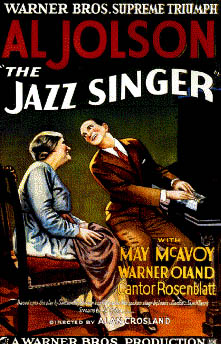 |
For The Jazz Singer, Warners recorded portions of the film with sound, and rewired their New York theater with speakers, so that when Al Jolson turned to his mother and said "Mama, listen, I'm gonna sing this like I will if I go on the stage," the audience heard as well as saw him saying it, and then heard the song as he sings it -- and the era of silent films was effectively over.
There were certainly several reasons why box office returns from Uncle Tom's Cabin lagged behind Universal's expectations, but among them must have been the fact that it could not compete for the public's attention with The Jazz Singer's soundtrack. Universal, at least, must have thought so. In April, 1927, it pulled the film from Los Angeles' Criterion Theatre in the middle of its scheduled run. According to a newspaper story about that decision, the Criterion immediately used the occasion to begin converting its theater to sound -- and around the same time Universal began preparing a new version of the film with what
publicity notices called "movie-tone synchronization." Almost a year after the film's New York premiere, in September 1928, this version was released in both Los Angeles and San Francisco. In San Francisco, Universal combined the new technology with time-tested promotional techniques, for the "sound" version of the film was supplemented with a live "atmospheric prologue" -- "including an augmented orchestra under Chad Rosebrook, Joe Roberts, the banjo king, and the Erma Powell revue."
|
It is the 1928 version, with "Musical Score Synchronized & Recorded by Erno Rapee," that survives today, as the film Universal deposited in the Library of Congress for copyright purposes. While adding a soundtrack doesn't seem to have improved the picture's popularity very much, it does mean we can hear as well as see the last major motion picture adaptation of Stowe's story as audiences around the country in the film's second year of release heard and saw it. This additional dimension suggests meanings that 21st-century viewers might not otherwise appreciate. Those audiences in 1928, for example, were led into the story by the two-minute overture that plays while the opening credits run. It's a medley of familiar songs, most or all of which were written in same era as Stowe's novel -- i.e. the 1840s and 1850s. But if you PLAY THE OVERTURE, the songs you'll hear, except for one African American spiritual, are from the realm of blackface minstrelsy, in most respects the antithesis to the place Stowe was trying to take her readers.
Rapee's score sounds much more like the pre-Talkie musical accompaniment than a modern movie soundtrack. There's only one word of dialogue (see below). But as a soundtrack it attempts to provide more than mood music by featuring various sound effects that were supposed to be perfectly synchronized with the visual images. These include:
a steamboat whistle and paddlewheel as George Harris escapes from Haley;
cannons firing as the Civil War begins;
even the sound of whips (this example, of Eliza fighting Loker while her son is being carried away, is one of the film's two occasions when slave women whip the white men who claim to own them, though the same sound is heard when Legree and his overseers whip Tom).
The seven additional clips below will allow you to hear representative samples of Rapee's soundtrack.
|
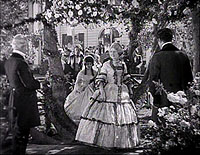
|
Eliza and George's Wedding: Apparently no new footage was added to the film for the sound version, but every point at which the original visuals implied a sound -- wind-blown snow or trees, slamming doors, or as here, a ringing bell -- provided a chance to incorporate a sound effect (usually made by the instruments of Rapee's orchestra). (Click on images left to view clips.) |
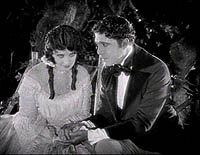
|
The Wedding Ball: In the clip above the light-skinned George and Eliza are carefully located visually between the Shelbys' black slaves and their white guests. The same physical distinctions are maintained during the scenes of singing and dancing that follow the wedding, and at the same time those racial categories are reinforced by the three very different musical styles you can hear -- for whites, mulattoes and blacks. |
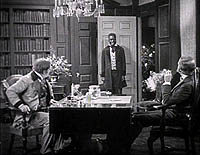
|
Entrance of Uncle Tom: Tom is returning from a business trip to Cincinnati with the money Shelby sent him to fetch, which explains how a slave came to be riding in a very elegant carriage. More striking is the dissonance here between music, picture and text. The words on the title introducing Tom call him a "contented servitor," and James Lowe's smiles as Tom indicate the same contentment, but the song that's playing, which becomes "Tom's theme" throughout the film, is "Nobody Knows the Trouble I've Seen." |
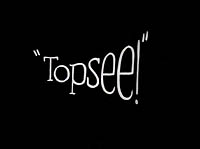
|
Ophelia Speaks: this clip contains the soundtrack's one line of "dialogue," repeated as Ophelia calls for Topsy; there's no way to tell if the special effect of the animated title was added to accompany the soundtrack or the way the film had at first tried to help viewers' imaginatively hear the originally silent scene (note that here, as often throughout the film, the "synchronization" of audio with video isn't perfect).
|
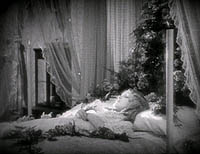
|
Death of Eva: at the beginning of the clip you'll hear an instance of the wind sound effect, but more significant is the way the soundtrack of Eva's ascension to heaven is unmistakably white and European; when Tom dies (below) no angel appears, and the voices we hear singing him to heaven are unmistakably black.
|
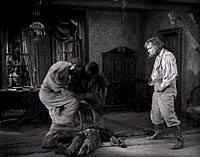
|
Death of Tom: This is one of two scenes where the soundtrack uses black performers singing an African American
spiritual (the other is when Haley carries Tom off the Shelby place); Legree's mental turmoil in the second half of the clip is one of the soundtrack's most original effects (the "Thematic Cue Sheet" called for a "Soft Timpany or Cymbal Roll" to orchestrate the "Revolving Wheel").
|
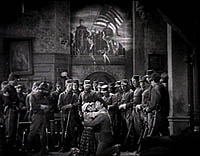
|
Reunion of Harris Family: The first song you'll hear in this clip is the motif that has accompanied the troubles the Harris family sees throughout the film; the second is of course "The Battle Hymn of the Republic" -- the unofficial anthem of the north during the Civil War, and so a kind of echo of "Dixie" at the end of the Overture. Is this the soundtrack's way of trying to reconcile North and South?
|








